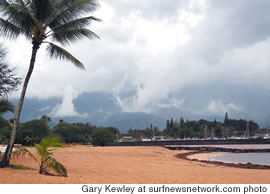Record Rainfall

Friday - March 31, 2006
| Share
 Del.icio.us
Del.icio.us
Oahu’s highest point, Ka‘ala Crater, is buried in low
clouds — a familiar sight this past month
Aloha, surfers and beach goers!
Wow, we live in historic times ... We’ve witnessed the longest-running string of bad weather in memory. Ask anyone. The sheer number of rainy periods that have swept through our Island chain in the past month is now at about eight ... count ‘em ... eight storms!
I called the National Weather Service and spoke to Kevin Kodama to be sure we were experiencing a “real” weather nightmare. We are. This is no dream. Kevin said that “The old record for rainfall has been ‘shattered’for Kauai and Oahu.” The amount of rainfall for Kauai for the past 30 days is 30 inches above normal for March - 30 inches! Two and a half feet above the average! Now that’s what I call being “shattered” by showers.
April is looking much brighter as far as the long-range forecast. We can count on the culprit upper atmosphere “Low Pressure” systems to our north and west to mellow out and leave us alone. Those of us who live and surf here can hardly wait, but I feel bad for those who visited and lost out. The past month so many visitors (about 250,000 a day) just got unlucky. Hawaii truly offers beautiful skies with clean, clear water 90 percent of the year.
This is still a tropical paradise, where the length of day and the temperature are relatively uniform throughout the year. Hawaii’s longest day is about 13.5 hours, and its shortest day is about 11 hours. Compare that to Southern California’s longest 14.5-hour day and shortest 10-hour day. Uniform day lengths mean small seasonal changes of incoming solar radiation (sunshine) and therefore temperature. If it’s a clear winter day, Hawaii gets about 65 percent (two-thirds) as much solar energy during the day as it does on a clear summer day. Sounds like a big drop, but not when you compare, for example, San Francisco, which only gets about 30 percent, or one-third, the sun energy during winter vs. summer.
Our ocean - the biggest on the planet - gives us moisture and acts like a huge thermostat. Its temperature doesn’t change much either, just like the air over the land. The seasonal range of sea temperatures is only 6 degrees (about 73 to near 80). The change between night and day is only 1 or 2 degrees! Southern Cal can have water go from 72 to 52 degrees ... summer to winter ... Brrrrrrr!
Hawaii is also the world’s most geographically isolated landmass ... 2,000 miles from the nearest continent. So, the air that finally reaches us spends enough time over the water to mellow out its harsher properties. For example, the freezing Arctic air can warm up as much as 100 degrees on its way to us. Thank God! At least we’re warm.
Well then ... what’s up with our weather this March? That’s a good question, and one that falls into Mother Nature’s hands. Generally speaking, March is a month where bad weather can “outdo” December through February. 1951 was the last year March saw such horrendous weather ... and it was about 20 inches over the average. Losses were nearly $1.3 million from flooding and agricultural losses! Current losses exceed that.
In the simplest terms, if you hear low pressure think “stormy/unstable weather.” And if you hear high pressure, think “sunshiny/stable weather.” In addition, storms have a track they follow. These tracks or paths usually migrate eastward. They are generally between 35 and 65 degrees latitude - or north to south. Think San Francisco to Alaska or Japan up to the NE of Russia. What’s cool is that storms and the Pacific high follow the seasonal shift of the sun! They move away to the north for summer and move south or toward Hawaii during the winter. It’s during the winter that these high pressure areas are weaker and the lows are stronger.
By the way, Hawaii is at about 20 degrees latitude, dude. Same as Guadalajara, Cuba, Mecca, Bombay, Thailand, Manila ...
What we have as of now are giant Kona (local) lows hanging out to the north and west - and they’re persistent buggas ... keeping us wet ... but we surfers are going to get wet anyway. The problem is the rain causes runoff, or dirty water. This is a whole other article. Check out surfnewsnetwork.com about the Ala Wai Canal spill and catch more surf next week right here.
I’m GQ, dropping in 4 U!
E-mail this story | Print this page | Comments (0) | Archive | RSS Comments (0) |
Most Recent Comment(s):













